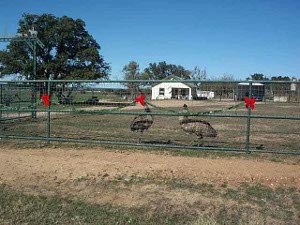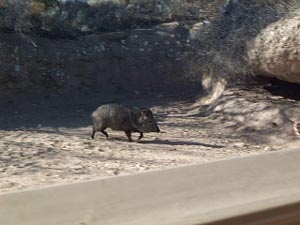We blew through Texas! We stayed Monday night in Beaumont, warm and humid and covered with Spanish moss and oil refineries. Tuesday we went through  Texas Christmas emus
Houston to San Antonio to have the truck inspected and re-registered for the year, pick up mail, get Elsa a new military dependent ID Card, and get Bob signed up for Medicare. San Antonio was warm and much dryer than Beaumont. We were on the road again by Thursday morning. We stopped for a German luncheon in Fredericksburg, then moved through the hill country, covered with live oaks, to San Angelo, where the farmers were busy harvesting their cotton. Along the way we said hello to two perky emus (see picture). Today, Friday, we drove through West Texas. We saw a wind farm, then watched the country get drier and drier as we headed into the desert. The chapparal grew sparser and the grazing livestock grew fewer. The herds of goats, sheep and cattle we saw in the morning had dwindled to a few cows picking their way through the desert vegetation by midafternoon. We drove right through the West Texas Permian oil field, where it seemed that about half of the wells were still pumping. We even saw some a couple of new wells being drilled. But the tiny little oil towns looked
Texas Christmas emus
Houston to San Antonio to have the truck inspected and re-registered for the year, pick up mail, get Elsa a new military dependent ID Card, and get Bob signed up for Medicare. San Antonio was warm and much dryer than Beaumont. We were on the road again by Thursday morning. We stopped for a German luncheon in Fredericksburg, then moved through the hill country, covered with live oaks, to San Angelo, where the farmers were busy harvesting their cotton. Along the way we said hello to two perky emus (see picture). Today, Friday, we drove through West Texas. We saw a wind farm, then watched the country get drier and drier as we headed into the desert. The chapparal grew sparser and the grazing livestock grew fewer. The herds of goats, sheep and cattle we saw in the morning had dwindled to a few cows picking their way through the desert vegetation by midafternoon. We drove right through the West Texas Permian oil field, where it seemed that about half of the wells were still pumping. We even saw some a couple of new wells being drilled. But the tiny little oil towns looked  Lion's Tail, Carlsbad Caverns
nearly deserted. As we approached Carlsbad, New Mexico, we encountered pecans, hay, cotton, and lots of livestock, due to the irrigation of the land.
Lion's Tail, Carlsbad Caverns
nearly deserted. As we approached Carlsbad, New Mexico, we encountered pecans, hay, cotton, and lots of livestock, due to the irrigation of the land.
Hundreds of thousands of bats make their summer home in the Carlsbad Caverns, swarming out at dusk each night; one former resident said it looks like a cyclone. They spend the winters in Mexico, though, so we visited a batless, but still fascinating, cavern. The park offers a variety of tours, mostly ranger-guided, designed to illustrate different aspects of the caverns and caving in general. We arrived mid-mornng and spent a pleasant couple of hours on the self-guided walk through the Big Room.
After descending 700 or so feet in a large elevator, we followed a paved route which winds through some of the more than 30 miles of explored caves -- volunteers are continuing to explore and map additional area, as well as correcting some of the older cave maps. We saw a great variety of formations, from pebbly popcorn to graceful draperies, the expected stalactites and stalagmites, pools of water, and other lovely mysterious-looking shapes. The areas are  Javelina, Living Desert Park
lighted only enough to provide views of the area, with spotlights tucked away shining on special areas -- none of the gaudy colored lights used by some of the more commercial caves.
Javelina, Living Desert Park
lighted only enough to provide views of the area, with spotlights tucked away shining on special areas -- none of the gaudy colored lights used by some of the more commercial caves.
After leaving the caverns we drove along the desert loop trail. The familiar (to us) yuccas, sotols, and cacti on the mountaintop and down the wash gave no hint of the immense and complex underground world below.
The following day we visited the Living Desert State Park. This was a pleasant surprise, offering more than had been advertised. The park is located on a hillside overlooking Carlsbad, with plenty of room for the display of local birds and animals, all of which were injured or otherwise unable to live in the wild. We took a leisurely stroll past hawks, owls, a raven, a vulture and an eagle, through a darkened display of snakes, spiders and scorpions, then back  Carlsbad Christmas decoration
outside for a lively prairie dog village, a gulch containing several wild boars (javelinas), deer, elk, bison, and a beautiful Mexican wolf.
Carlsbad Christmas decoration
outside for a lively prairie dog village, a gulch containing several wild boars (javelinas), deer, elk, bison, and a beautiful Mexican wolf.
We drove along the Pecos river and enjoyed seeing some New Mexico-style houses, many displaying the particular Southwest Christmas outdoor luminarias. Here, technology has triumphed. In earlier years, candles stuck in sand-filled paper sacks provided glowing lights; today many homes sported shiny paper-bag-like covers over electric lights.
The town of Carlsbad, like other small New Mexico towns, resembles many desert towns in the west, with a mixture of farming, ranching and tourism. One difference is the presence of oil wells, tanks, pipelines and even small refineries. The cows and sheep don't seem to mind the stinky odor of natural gas. But the oil profits haven't permeated the town as well as the odors, for there were plenty of indigent families gathered for the free roast turkey dinner at one of the local cafes.
 Texas Christmas emus
Houston to San Antonio to have the truck inspected and re-registered for the year, pick up mail, get Elsa a new military dependent ID Card, and get Bob signed up for Medicare. San Antonio was warm and much dryer than Beaumont. We were on the road again by Thursday morning. We stopped for a German luncheon in Fredericksburg, then moved through the hill country, covered with live oaks, to San Angelo, where the farmers were busy harvesting their cotton. Along the way we said hello to two perky emus (see picture). Today, Friday, we drove through West Texas. We saw a wind farm, then watched the country get drier and drier as we headed into the desert. The chapparal grew sparser and the grazing livestock grew fewer. The herds of goats, sheep and cattle we saw in the morning had dwindled to a few cows picking their way through the desert vegetation by midafternoon. We drove right through the West Texas Permian oil field, where it seemed that about half of the wells were still pumping. We even saw some a couple of new wells being drilled. But the tiny little oil towns looked
Texas Christmas emus
Houston to San Antonio to have the truck inspected and re-registered for the year, pick up mail, get Elsa a new military dependent ID Card, and get Bob signed up for Medicare. San Antonio was warm and much dryer than Beaumont. We were on the road again by Thursday morning. We stopped for a German luncheon in Fredericksburg, then moved through the hill country, covered with live oaks, to San Angelo, where the farmers were busy harvesting their cotton. Along the way we said hello to two perky emus (see picture). Today, Friday, we drove through West Texas. We saw a wind farm, then watched the country get drier and drier as we headed into the desert. The chapparal grew sparser and the grazing livestock grew fewer. The herds of goats, sheep and cattle we saw in the morning had dwindled to a few cows picking their way through the desert vegetation by midafternoon. We drove right through the West Texas Permian oil field, where it seemed that about half of the wells were still pumping. We even saw some a couple of new wells being drilled. But the tiny little oil towns looked  Lion's Tail, Carlsbad Caverns
nearly deserted. As we approached Carlsbad, New Mexico, we encountered pecans, hay, cotton, and lots of livestock, due to the irrigation of the land.
Lion's Tail, Carlsbad Caverns
nearly deserted. As we approached Carlsbad, New Mexico, we encountered pecans, hay, cotton, and lots of livestock, due to the irrigation of the land.
 Javelina, Living Desert Park
Javelina, Living Desert Park Carlsbad Christmas decoration
Carlsbad Christmas decoration